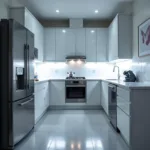Color matching is the process of reproducing a specific color to achieve consistency across different mediums or applications. Whether you’re trying to match a paint color for your walls, find the perfect fabric to complement your furniture, or ensure your brand colors are consistent across digital and print platforms, color matching plays a crucial role. It’s a blend of art and science, requiring a keen eye, technical understanding, and often, specialized tools.
Understanding the Nuances of Color Matching
Color matching isn’t as simple as picking a color chip that looks close. It delves into the intricacies of how we perceive color, the properties of different materials, and the influence of lighting conditions. Factors such as the surface texture, the type of pigment used, and even the surrounding environment can significantly impact how a color appears. This is why a color that looks perfect on a small swatch might look entirely different when applied to a larger area or viewed under different lighting.
Accurate color matching is essential in various industries, including interior design, fashion, printing, and manufacturing. Imagine a company’s logo appearing in slightly different shades on its website, business cards, and product packaging. Such inconsistencies can damage brand identity and create a sense of unprofessionalism.
 Color Matching Tools and Techniques
Color Matching Tools and Techniques
How Does Color Matching Work?
There are several methods for color matching, ranging from simple visual comparisons to sophisticated technological solutions.
- Visual Comparison: This traditional method involves comparing a sample color against a set of standard color chips or swatches under controlled lighting. While cost-effective, it’s subjective and prone to human error.
- Spectrophotometry: This scientific approach utilizes a spectrophotometer to measure the light reflected or transmitted by a color sample. It provides objective data, allowing for precise color matching and formulation.
- Colorimetry: This method uses colorimeters to measure the color in terms of its three primary components: red, green, and blue. It’s often used in digital imaging and display calibration.
The choice of method depends on the level of accuracy required and the application. For instance, while visual comparison might suffice for a DIY home painting project, industries like textile manufacturing and graphic design demand the precision of spectrophotometry.
Why is Color Matching Important?
Color matching is crucial for several reasons:
- Brand Consistency: Maintaining consistent brand colors across all platforms reinforces brand recognition and builds trust.
- Product Quality: Accurate color matching ensures that products meet specific color standards and customer expectations.
- Aesthetic Appeal: In interior design and fashion, color matching creates harmonious and visually appealing spaces and ensembles.
- Efficiency and Cost Savings: Precise color matching minimizes rework and material waste, leading to cost savings.
What are the Challenges in Color Matching?
Several factors can make color matching a complex process:
- Metamerism: This phenomenon occurs when two colors appear identical under one light source but different under another. It’s a common challenge when matching colors across different materials.
- Surface Texture: The texture of a surface can influence how light is reflected, affecting the perceived color. A rough surface will scatter light more than a smooth surface, making the color appear lighter.
- Human Perception: Individual variations in color perception can lead to subjective interpretations of color matches.
- Technological Limitations: Even with advanced tools, achieving a perfect color match can be challenging due to limitations in color gamut and reproduction capabilities.
Tips for Successful Color Matching
Here are some tips to achieve accurate and effective color matching:
- Use Standardized Lighting: Always view and compare colors under standardized lighting conditions, such as daylight or a designated light booth.
- Consider the Surface: Take into account the texture and finish of the surface when selecting colors.
- Use Professional Tools: Invest in quality color matching tools, such as spectrophotometers or colorimeters, for precise results.
- Work with Experienced Professionals: Consult with color experts or professionals in your industry for guidance and support.
Remember, color is more than just a visual element; it’s a powerful tool that can evoke emotions, influence perceptions, and enhance the overall experience. By understanding the principles of color matching and utilizing the right tools and techniques, you can unlock the full potential of color in your projects and endeavors.
does-lowes-do-color-match provide an example of professional matching service. Similar to does-lowes-do-paint-color-matching, understanding the process of metamerism is crucial.
Conclusion
Color matching is a critical aspect of achieving color harmony and consistency across various applications. By understanding the science behind color, the factors that influence color perception, and the available tools and techniques, you can master the art of color matching and create visually stunning results. Whether you’re a professional designer or a DIY enthusiast, accurate color matching empowers you to bring your vision to life with precision and confidence. For those keen on exploring exterior color options, which-is-the-best-matching-color-for-gray-homes-exterior offers valuable insights. which is the best matching color for gray house exterior and does lowes color match paint also provide useful resources.
FAQ
- What is metamerism?
- How do I choose the right color matching method?
- What are the benefits of using a spectrophotometer?
- How can I avoid color matching errors?
- What is the difference between color matching and color correction?
- How does lighting affect color perception?
- Where can I find professional color matching services?
For further support, contact us at Phone Number: 0373298888, Email: [email protected] or visit our address: 86 Cau Giay, Hanoi. Our customer service team is available 24/7.

